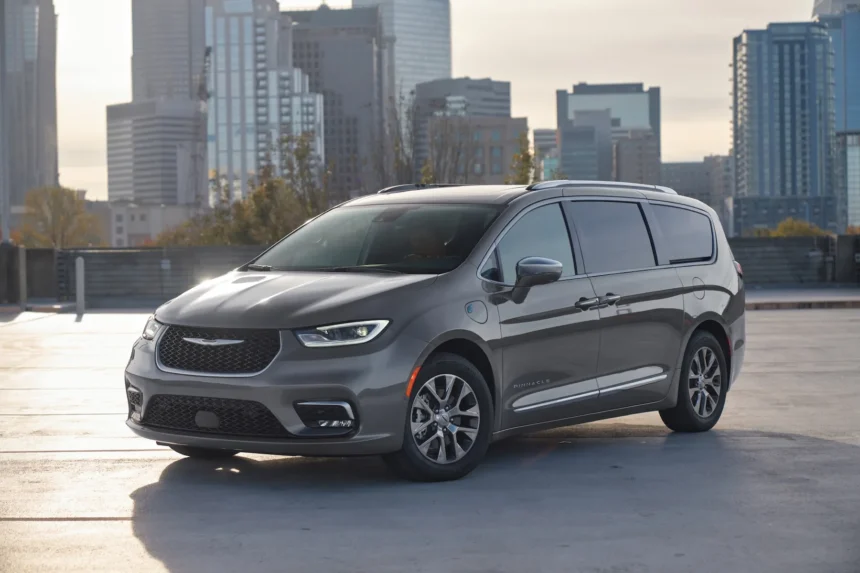The minivan has long been the go-to vehicle for suburban families, offering ample seating, versatile cargo space, and easy sliding doors. However, in recent years, SUVs have gained popularity, leaving the minivan in need of a powertrain upgrade to compete. Now, with the introduction of all-wheel drive and hybrid options for the 2025 Chrysler Pacifica and Toyota Sienna, the minivan segment is more competitive than ever.
Previously, the Toyota Sienna was the only all-wheel-drive minivan option, but now the Chrysler Pacifica also offers this feature. Additionally, the Toyota Sienna comes standard as a hybrid, boasting an EPA-rated 35 mpg combined with all-wheel drive. With both minivans offering new powertrain options, the decision between the two has become more challenging.
When comparing trims, the Chrysler Pacifica offers more variety with options ranging from Touring to Pinnacle editions, including a Voyager model and a Pacifica Hybrid with Select, Touring L, and Pinnacle trims. On the other hand, the Toyota Sienna is available in LE, XLE, Woodland, XSE, Limited, and Platinum trims. The Pacifica is praised for its variety, while the Sienna offers a new Woodland model.
In terms of pricing and features, the base prices for both minivans are below $40,000 but can exceed $60,000 for fully loaded models. The Sienna comes with power sliding doors, safety technology, and a touchscreen with Apple CarPlay and Android Auto. The Pacifica offers similar features with additional options like leather upholstery, navigation, and a sunroof. The Sienna Platinum with all-wheel drive costs around $58,000, while the Hybrid Pinnacle edition of the Pacifica exceeds $60,000.
When it comes to gas mileage, the Toyota Sienna outperforms the Chrysler Pacifica with an EPA-rated 35 mpg combined compared to the Pacifica’s 20 mpg combined with all-wheel drive. However, the Pacifica Hybrid offers an impressive 32-mile electric range and 30 mpg combined without electric power. The Sienna is more efficient in base spec, while the Pacifica excels as a plug-in hybrid.
In terms of interior and cargo space, the Chrysler Pacifica offers a more high-end look and a more useful seating system with features like Stow ‘N Go fold-away seats. The Sienna has a smaller third-row seat but includes a convenient dashboard storage shelf and a two-tiered center console for additional storage space. The Pacifica’s premium fit and finish outshine the Sienna’s utilitarian design.
Overall, both the Chrysler Pacifica and Toyota Sienna offer compelling options for minivan buyers, with each excelling in different areas. The Pacifica stands out for its variety of trims and premium features, while the Sienna impresses with its efficiency and practical interior design. Ultimately, the choice between the two minivans comes down to personal preference and priorities. Toyota Sienna: A Detailed Comparison
When it comes to minivans, the Chrysler Pacifica and Toyota Sienna are two popular choices for families looking for space, comfort, and versatility. One key consideration for many buyers is the seating configuration and comfort in the second and third rows.
The fixed position of the Pacifica’s second row limits third-row space, though the third rows in both minivans recline for increased comfort. The Sienna, on the other hand, offers a different advantage with second-row seats that can slide up to 25 inches, making accessing the third row much easier. The Sienna also has more seating room and legroom to comfortably fit two adults in the front two rows. While the second row in the Sienna cannot be removed due to airbags, the seats can flip up and move up flush against the front seat backs for added cargo space.
In terms of cargo space, the Pacifica offers more cubic feet with both rows folded flat compared to the Sienna. However, the Sienna has a lower load floor from the rear, making it easier to load and unload cargo.
When it comes to performance, the Pacifica’s 287-hp 3.6-liter V-6 engine provides quicker acceleration compared to the Sienna. The Sienna, on the other hand, features a 2.5-liter inline-4 engine with a 1.9-kwh battery powering an electric motor for a total of 245 hp. Both minivans offer responsive power output, with the Pacifica offering all-wheel drive on select models.
In terms of safety features, both the Sienna and Pacifica come standard with automatic emergency braking, adaptive cruise control, and lane-keeping assist. The Pacifica adds blind-spot monitors, while both offer optional surround-view camera systems and cabin cameras. Both minivans have earned top safety ratings, with the Pacifica offering slightly more standard safety equipment.
When it comes to design, the Pacifica has a more upscale feel with rounded and elegant styling, while the Sienna borrows design elements from the Toyota Highlander. The Pacifica is praised for its sportier appearance and more attractive interior.
In terms of infotainment, the Pacifica offers more features and a larger touchscreen display compared to the Sienna. Both minivans come standard with Apple CarPlay, Android Auto, and Amazon Alexa compatibility.
When it comes to warranty coverage, both minivans offer similar bumper-to-bumper and powertrain warranties. However, the Sienna has a longer battery warranty for its hybrid models and includes two years or 25,000 miles of free scheduled service.
In conclusion, both the Chrysler Pacifica and Toyota Sienna have their own strengths and advantages. The Pacifica offers a more upscale design, better performance, and more standard safety features, while the Sienna provides more seating and cargo space, as well as a longer battery warranty. Ultimately, the choice between the two minivans will depend on individual preferences and priorities. When it comes to choosing the best minivan for your family, the Toyota Sienna and Chrysler Pacifica are two top contenders in the market. Both offer excellent safety features, spacious interiors, and reliability that families look for in a minivan. However, there are some key differences between the two that may sway your decision one way or the other.
In terms of overall ratings, the Chrysler Pacifica has a slight edge with a TCC Rating of 6.7 out of 10 compared to the Sienna’s 6.7. The Pacifica has long been considered the best family hauler on the market, with superior performance and flexibility. However, the competition is catching up, with the Sienna and the Kia Carnival offering similar safety and space features.
One area where the Pacifica shines is in fuel economy. The Pacifica can overcome the Sienna’s deficit in fuel economy, especially if you opt for the plug-in hybrid edition. However, upgrading to the hybrid edition can be costly and may result in sacrificing the fold-away second-row seats, which are a convenient feature for families.
On the other hand, the Toyota Sienna stands out for its impressive gas mileage and handling. The Sienna is refined and offers excellent gas mileage across all models. However, the middle-row seats do not fold out of the way, and the third-row seating is slightly less spacious compared to the Pacifica. Despite this, the Sienna may be easier to access and maneuver in tight spaces.
In the end, the decision between the two minivans comes down to personal preference and priorities. If fuel economy and utility are top priorities for you, the Pacifica may be the better choice. However, if handling and hybrid gas mileage are more important, the Sienna may be the way to go. Ultimately, both minivans offer a range of features that make them worthy contenders for any family in the market for a reliable and spacious vehicle. The world is constantly changing, and with it, so are the ways in which we interact and communicate with one another. In recent years, social media has become an integral part of our daily lives, allowing us to connect with friends and family, share our thoughts and experiences, and even make new connections with people from all around the world.
But as social media continues to evolve, so too do the ways in which we use it. One of the most prominent trends in social media today is the rise of live streaming. Live streaming allows users to broadcast video content in real-time, giving viewers a unique and engaging way to connect with their favorite creators and influencers.
There are a variety of platforms that offer live streaming capabilities, including Facebook, Instagram, YouTube, and Twitch. Each platform has its own unique features and audience, but they all share the common goal of providing users with a way to share their experiences and connect with others in a more immediate and intimate way.
One of the key reasons why live streaming has become so popular is its ability to create a sense of authenticity and immediacy. Unlike pre-recorded videos or posts, live streams allow viewers to see and interact with the creator in real-time, creating a more personal and engaging experience. This sense of authenticity has helped to foster a strong sense of community within the live streaming world, with viewers and creators alike forming close bonds and connections through their shared experiences.
Another reason for the popularity of live streaming is the sheer variety of content that is available. From gaming streams to cooking shows to music performances, there is truly something for everyone in the world of live streaming. This diversity of content has helped to attract a wide range of viewers, making live streaming a truly universal form of entertainment.
In addition to its entertainment value, live streaming has also proven to be a valuable tool for businesses and brands. Many companies are now using live streaming as a way to connect with their customers and showcase their products and services in a more engaging and interactive way. By leveraging the power of live streaming, businesses can reach a wider audience and create a more memorable and impactful brand experience.
As live streaming continues to grow in popularity, it is clear that this trend is here to stay. With its ability to create authentic connections, provide a wide range of content, and offer valuable opportunities for businesses, live streaming has become an essential part of the social media landscape. Whether you are a creator looking to connect with your audience, a viewer looking for engaging content, or a business looking to reach new customers, live streaming has something to offer for everyone.







